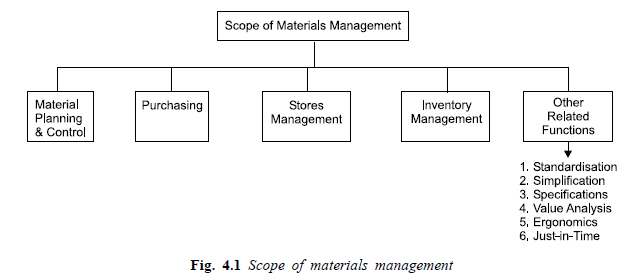Materials management is defined as “the function responsible for the coordination of planning, sourcing, purchasing, moving, storing and controlling materials in an optimum manner so as to provide a pre-decided service to the customer at a minimum cost”.
From the definition it is clear that the scope of materials management is vast. The functions of materials management can be categorized in the following ways: (as shown in Fig. 4.1.)
- Material Planning and Control
- Purchasing
- Stores Management
- Inventory Control or Management
- Standardisation
- Simplification
- Value Analysis
- Erogonomics
- Just-in-Time (JIT)
All the above mentioned functions of materials management has been discussed in detail in this chapter.

- Materials planning and control: Based on the sales forecast and production plans, the materials planning and control is done. This involves estimating the individual requirements of parts, preparing materials budget, forecasting the levels of inventories, scheduling the orders and monitoring the performance in relation to production and sales.
- Purchasing: This includes selection of sources of supply finalization in terms of purchase, placement of purchase orders, follow-up, maintenance of smooth relations with suppliers, approval of payments to suppliers, evaluating and rating suppliers.
- Stores management or management: This involves physical control of materials, preservation of stores, minimization of obsolescence and damage through timely disposal and efficient handling, maintenance of stores records, proper location and stocking. A store is also responsible for the physical verification of stocks and reconciling them with book figures. A store plays a vital role in the operations of a company.
- Inventory control or management: Inventory generally refers to the materials in stock. It is also called the idle resource of an enterprise. Inventories represent those items, which are either stocked for sale or they are in the process of manufacturing or they are in the form of
materials, which are yet to be utilized. The interval between receiving the purchased parts and transforming them into final products varies from industries to industries depending upon the cycle time of manufacture. It is, therefore, necessary to hold inventories of various kinds to act as a buffer between supply and demand for efficient operation of the system. Thus, an effective control on inventory is a must for smooth and efficient running of the production cycle with least interruptions. - Other related activities
- 3S
- Standardization: Standardization means producing maximum variety of products from the minimum variety of materials, parts, tools and processes. It is the process of establishing standards or units of measure by which extent, quality, quantity, value, performance etc. may be compared and measured.
- Simplification: The concept of simplification is closely related to standardization. Simplification is the process of reducing the variety of products manufactured. Simplification is concerned with the reduction of product range, assemblies, parts, materials and design.
- Specifications: It refers to a precise statement that formulizes the requirements of the customer. It may relate to a product, process or a service.
Example: Specifications of an axle block are Inside Dia. = 2 ± 0.1 cm, Outside Dia. = 4 ± 0.2 cm and Length = 10 ± 0.5 cm.
- Value analysis: Value analysis is concerned with the costs added due to inefficient or unnecessary specifications and features. It makes its contribution in the last stage of product cycle, namely, the maturity stage. At this stage research and development no longer make positive contributions in terms of improving the efficiency of the functions of the product or adding new functions to it.
- Ergonomics (Human Engineering): The human factors or human engineering is concerned with man-machine system. Ergonomics is “the design of human tasks, man-machine system, and effective accomplishment of the job, including displays for presenting information to human sensors, controls for human operations and complex man-machine systems.” Each of the above functions are dealt in detail.
Source: KumarAnil, Suresh N. (2009), Production and operations management, New Age International Pvt Ltd; 2nd Ed. edition.

29 May 2021
31 May 2021
29 May 2021
31 May 2021
31 May 2021
31 May 2021